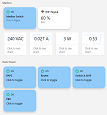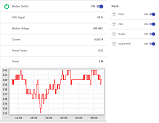Smart Farms
A DIY Guide to Remote Monitoring, Control & Surveillance on a Rural Property
Modern rural properties have the need for access to remote devices for:
| Monitoring | Control | Surveillance |
|---|---|---|
|
|
|
Building a solution for these needs can be broken down to these elements.
- The Golden rule
- Wireless networking the various outposts
- Solar power (if needed)
- Monitoring/Surveillance sensors
- Relays and Switches
- Video cameras
- Central Management
The Golden Rule
Make sure every component in the smart farm works on a "TCP/IP" network. That generally means that it has built-in WiFi and/or a LAN cable connection. Such devices can normally be connected to a computer network ("LAN") and accessed from smart phones, tablets, and desktop computers.
For example, don't use cameras that have analog video output; you will have a lot of problems viewing the image remotely. Similarly for sensors; make sure they are network capable.
Also, look for networked devices that are powered via Power over Ethernet (PoE), as this greatly reduces the complexity (i.e. cabling & component count) at each outpost.
Wireless Networking

Click image to enlarge
A key part of the solution will involve making network connections from some sort of base location (e.g. the manager's house) to various remote outposts. This part is actually easy using the Ubiquiti airMAX product range. airMAX is designed for network connections that are: cheap, fast, robust, wireless, and long-distance. Clear line of sight is required between the airMAX products but this can be solved with 'repeater' nodes that get over (or around) obstructions.
In many cases, each remote outpost will also need local WiFi. For outdoors WiFi we recommend the UAP-AC-M. For Indoors WiFi we recommend the UAP-AC-LITE. All are PoE powered.
Think of an airMAX network of an extension of the base location's computer network using "LAN cables in the sky".
How do you design the airMAX network? Easy! Send us an email with a map of the property showing the various locations that need to be connected.
Solar Power

Click image to enlarge
If solar power is needed at some outposts, then it is essential that the solar system also supports powering the various components. Ubiquiti airMAX products use 24 V PoE. Many cameras and other devices use 48 V PoE.
We recommend this PoE Solar UPS Switch that bundles into one neat package:
- Solar charger, with battery and solar panel connections. Including protection of battery over charge & over drain.
- 24 V PoE
- 48 V PoE
- LAN switch
Monitoring Sensors
We have these smart sensors available.
| Monitor | Product |
|---|---|
| Temperature | SG-TEMP |
| Switch closure | SS-1CHPro |
| SR-2CH | |
| Fluid level | SG-RANGE |
Relays and Switches

Click image to enlarge
To turn things on/off remotely, some form of network connected relay/switch is required. There are many 'Smart Home' devices that would seem to fit the bill, but they generally have these problems:
- Can only be controlled by some other smart device such as an App on a phone, or a voice command "OK Google, ...". Direct control is next to impossible.
- MUST have an Internet connection to the manufacturer's server. This can be a show-stopper in some cases, and is also a security risk.
We recommend these Tasmota-Plus solutions because they do NOT need an Internet connection, and offer powerful direct control plus many built-in features:
- Smart Power Plug, with Energy Monitoring. Switch one 240V AC socket ON/OFF, with remote voltage/power monitoring.
- Smart Power Strip (4 outlets). Switch four 240V AC sockets ON/OFF.
- Smart 1 Channel Relay & Switch. Switch one SPST relay ON/OFF, and monitor the status of one external switch/contact (OPEN/CLOSED).
- Smart 2 Channel Relay & Switch. Switch two SPST relays ON/OFF, and monitor the status of two external switch/contacts (OPEN/CLOSED).
- Smart 4 Channel Relay. Switch four independent SPDT relays ON/OFF.
- Smart Thermostat. One temperature controlled SPST relay .
Video Cameras

Click image to enlarge
The Ubiquiti Protect video system is ideal for remote surveillance. The product range includes:
- PoE powered, networked, outdoor cameras; including some models with night vision.
- Network Video Recorders (NVRs) that can optionally store video (continuous or motion only) for later playback.
Central Management
Tasmota (and Tasmota-Plus) devices operate perfectly well as stand alone devices; you can Monitor and Control the device via the built-in web pages.
But, what if:
- You have lots of devices, and would prefer to Monitor & Control them from a single Screen?
- You want Device#1 to control Device#2.
e.g. IF water level is too low THEN turn pump on. - More ...
This is possible, and in a fashion that will be very recognisable to anyone that has used the UniFi Controller to Monitor & Control UniFi devices. The difference is that the software to do this is all open-source and based on public protocols. Examples of IoT Platform software that can do all this are HomeAssistant (Recommended) or openHAB
Using IoT Platforms with Tasmota (and other MQTT compatible devices)
In simple terms:
- MQTT compatible devices (e.g. Tasmota) connect to an MQTT Broker.
Status information sent TO the MQTT broker.
Commands received FROM the MQTT broker. Your IoT Platform also connects to the MQTT broker. - Status information received FROM the MQTT broker.
Commands sent TO the MQTT broker.
Users interact via web pages (WebGUI) from the IoT Platform.

Click image to expand
The images below show openHAB visualisations from these products: SP-Plug-AU & SP-Strip-AU.
| Classic UI Mobile friendly |  Click image to enlarge |
| Basic UI Mobile friendly |  Click image to enlarge |
| Panel UI Ideal for touch screens |  Click image to enlarge |
PoE to Low Voltage DC
Sometimes at a remote solar outpost you may need low voltage DC. We have these PoE converters available:
- 48 V PoE to USB-C (5 V). See POE-SPLIT-USBC.
- 48 V PoE to USB-micro (5 V). See POE-SPLIT-USBM.
- 48 V PoE to DC Plug (12 V). See POE-SPLIT-12V.

Distributing Starlink
I have Starlink on my property. Now what? We get a lot of calls from rural properties wanting to distribute the …
- Model
- INFO-STARLINK

Smart LAN & WiFi, 2 Channel Relay & Switch
Description This device has: 3 network Interfaces: A LAN (Ethernet) interface: Connects to a Local Area Network (LAN) using a standard Cat5e/Cat6 …
- Model
- SR-2CH
- Availabilty
- 7


Smart LAN & WiFi, 4 Channel Relay & Switch
Description This device has: 3 network Interfaces: A LAN (Ethernet) interface: Connects to a Local Area Network (LAN) using a standard Cat5e/Cat6 …
- Model
- SR-4CH
- Availabilty
- 0

0 items

Ubiquiti has authorised us as a Warranty Return Centre.
That means we can process Ubiquiti warranty returns in Australia.





